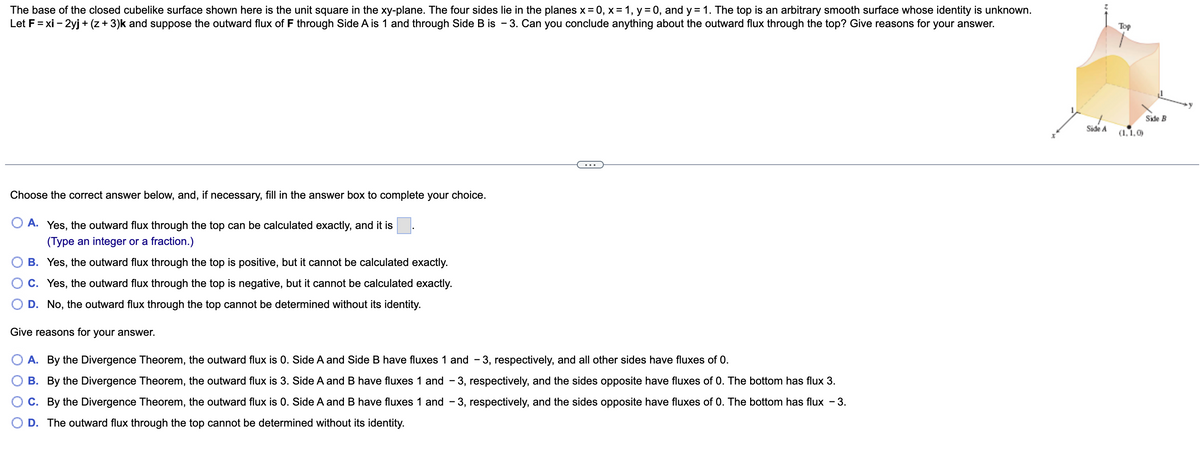i-2yj + (z+3)k and suppose the outward flux of F through Side A is 1 and through Side B is -3. Can you conclude anything about the outward flux through the top? Give reasons for your answer.
i-2yj + (z+3)k and suppose the outward flux of F through Side A is 1 and through Side B is -3. Can you conclude anything about the outward flux through the top? Give reasons for your answer.
Algebra & Trigonometry with Analytic Geometry
13th Edition
ISBN:9781133382119
Author:Swokowski
Publisher:Swokowski
Chapter11: Topics From Analytic Geometry
Section: Chapter Questions
Problem 18T
Related questions
Question

Transcribed Image Text:Top
The base of the closed cubelike surface shown here is the unit square in the xy-plane. The four sides lie in the planes x=0, x= 1, y = 0, and y = 1. The top is an arbitrary smooth surface whose identity is unknown.
Let F=xi - 2yj + (z + 3)k and suppose the outward flux of F through Side A is 1 and through Side B is - 3. Can you conclude anything about the outward flux through the top? Give reasons for your answer.
Side A
Choose correct answer below, and, if necessary, fill in the answer box to complete your choice.
A. Yes, the outward flux through the top can be calculated exactly, and it is
(Type an integer or a fraction.)
B. Yes, the outward flux through the top is positive, but it cannot be calculated exactly.
C. Yes, the outward flux through the top is negative, but it cannot be calculated exactly.
D. No, the outward flux through the top cannot be determined without its identity.
Give reasons for your answer.
O A. By the Divergence Theorem, the outward flux is 0. Side A and Side B have fluxes 1 and -3, respectively, and all other sides have fluxes of 0.
B. By the Divergence Theorem, the outward flux is 3. Side A and B have fluxes 1 and -3, respectively, and the sides opposite have fluxes of 0. The bottom has flux 3.
C. By the Divergence Theorem, the outward flux is 0. Side A and B have fluxes 1 and 3, respectively, and the sides opposite have fluxes of 0. The bottom has flux 3.
D. The outward flux through the top cannot be determined without its identity.
(1.1.0)
Side B
Expert Solution
This question has been solved!
Explore an expertly crafted, step-by-step solution for a thorough understanding of key concepts.
This is a popular solution!
Trending now
This is a popular solution!
Step by step
Solved in 4 steps with 3 images

Recommended textbooks for you

Algebra & Trigonometry with Analytic Geometry
Algebra
ISBN:
9781133382119
Author:
Swokowski
Publisher:
Cengage

Elementary Geometry For College Students, 7e
Geometry
ISBN:
9781337614085
Author:
Alexander, Daniel C.; Koeberlein, Geralyn M.
Publisher:
Cengage,

Algebra & Trigonometry with Analytic Geometry
Algebra
ISBN:
9781133382119
Author:
Swokowski
Publisher:
Cengage

Elementary Geometry For College Students, 7e
Geometry
ISBN:
9781337614085
Author:
Alexander, Daniel C.; Koeberlein, Geralyn M.
Publisher:
Cengage,